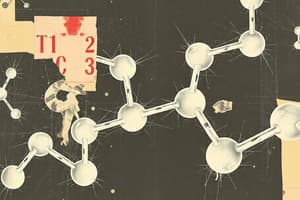Podcast
Questions and Answers
What distinguishes alkanes from unsaturated hydrocarbons?
What distinguishes alkanes from unsaturated hydrocarbons?
- Alkanes are highly reactive.
- Alkanes contain carbon–carbon double bonds.
- Alkanes contain benzene rings.
- Alkanes contain only carbon–carbon single bonds. (correct)
How do the boiling points of alkanes generally change with molecular weight?
How do the boiling points of alkanes generally change with molecular weight?
- They increase with increasing molecular weight. (correct)
- They fluctuate unpredictably.
- They decrease with increasing molecular weight.
- They remain constant regardless of molecular weight.
Which statement about the solubility of alkanes is true?
Which statement about the solubility of alkanes is true?
- Alkanes are soluble in nonpolar organic compounds. (correct)
- Alkanes dissolve well in polar solvents.
- Alkanes are soluble in water.
- Alkanes are highly soluble in ionic solutions.
What effect does branching have on the boiling point of alkanes?
What effect does branching have on the boiling point of alkanes?
What is a characteristic of high-molecular-weight alkanes?
What is a characteristic of high-molecular-weight alkanes?
What defines a functional group in organic chemistry?
What defines a functional group in organic chemistry?
Why are alkanes not soluble in water?
Why are alkanes not soluble in water?
Which of the following statements about aliphatic hydrocarbons is correct?
Which of the following statements about aliphatic hydrocarbons is correct?
Which type of bond is typically present between carbon and hydrogen in hydrocarbons?
Which type of bond is typically present between carbon and hydrogen in hydrocarbons?
How are polar molecules characterized in relation to their intermolecular interactions?
How are polar molecules characterized in relation to their intermolecular interactions?
What property do hydrophilic substances typically have that allows them to form hydrogen bonds?
What property do hydrophilic substances typically have that allows them to form hydrogen bonds?
Which factor contributes most to a molecule's net polarity?
Which factor contributes most to a molecule's net polarity?
Which type of force is primarily responsible for the pairing of DNA strands?
Which type of force is primarily responsible for the pairing of DNA strands?
What is the main characteristic of substances that are hydrophobic?
What is the main characteristic of substances that are hydrophobic?
What is true about polar covalent bonds based on electronegativity differences?
What is true about polar covalent bonds based on electronegativity differences?
What defines a hydrocarbon?
What defines a hydrocarbon?
Flashcards are hidden until you start studying
Study Notes
Polarity and Intermolecular Forces
- Polar Covalent Bonds: Electrons are shared unequally between atoms with different electronegativities.
- Bond Polarity: If the electronegativity difference is less than 0.5, the bond is nonpolar. Between 0.5 and 2, the bond is polar covalent. Over 2, the bond is mostly ionic.
- C-H Bonds: These are nonpolar.
- Oxygen-Carbon & Nitrogen-Carbon Bonds: These are polar bonds.
- Dipole Moments: Occur when a molecule has a net positive and negative end due to uneven electron distribution, making it polar.
Intermolecular Forces
- Dipole-Dipole Forces: Attractions between polar molecules caused by electrostatic interactions.
- Dispersion Forces: Occur between all molecules due to temporary fluctuations in electron distribution.
- Hydrogen Bonds: A strong attraction between a hydrogen atom bonded to a highly electronegative atom like oxygen or nitrogen and a lone pair of electrons on another oxygen or nitrogen atom.
- Significance:
- Keeps water liquid
- Maintains enzyme shape
- Allows DNA strands to bond and coil to form a double helix
- Significance:
Hydrophilic and Hydrophobic
- Hydrophilic: Substances that dissolve in water, often containing polar groups like -OH, forming hydrogen bonds.
- Hydrophobic: Substances that don't dissolve in water, lacking groups that form hydrogen bonds.
Hydrocarbons
- Hydrocarbons: Compounds containing only carbon and hydrogen atoms.
- Alkanes: Saturated hydrocarbons containing only single C-C bonds.
- Unsaturated Hydrocarbons: Contain one or more C=C double bonds, C≡C triple bonds, or benzene rings.
- Aliphatic Hydrocarbons: Alkanes with properties similar to fats and oils.
Properties of Hydrocarbons
- Melting and Boiling Points:
- Increase with increasing molecular weight.
- Generally lower than other compounds of similar molecular weight.
- Solubility:
- Nonpolar - insoluble in water, soluble in other nonpolar solvents like toluene and diethyl ether.
Functional Groups
- Definition: Specific atoms or groups of atoms within a molecule that determine its chemical and physical properties.
- Significance:
- Determine the chemical reactivity of a molecule.
- Often impact physical properties of a compound.
Studying That Suits You
Use AI to generate personalized quizzes and flashcards to suit your learning preferences.



